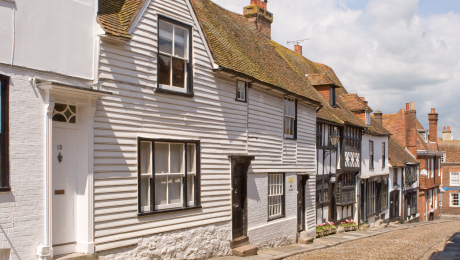Environmental Control of House Dust Mites: Validation of a Combined Hygrothermal Population Model
The original project successfully developed a sophisticated hygrothermal population model of house dust mites in beds. This new 2-year follow-up project improves the model and tests it in homes

6 February 2017
Inhaled allergens derived from house dust mite (HDM) faeces play a major role in allergic disease, especially in asthma. The number of people affected is rising throughout Europe (and indeed worldwide), now impairing the health and quality of life of a substantial proportion of children, as well as many adults, and placing a significant burden on health services.
It is known that temperature and humidity play an important role in house-dust mite physiology, hence building and room hygrothermal conditions are important since they in turn affect the mite microclimates. This EPSRC-funded project builds upon the completed EPSRC-funded project A Hygrothermal Model for Predicting House Dust Mite Response to Environmental Conditions in Dwellings.
The original EPSRC-funded project successfully developed a sophisticated hygrothermal population model of house dust mites in beds. This new 2-year follow-up project, also funded by EPSRC, improves the model and tests it in homes around the UK. The project represents the next step in developing the model for use in devising anti-mite strategies for a range of UK house types. It includes laboratory monitoring of mite population growth in a range of conditions, to generate data essential to the effectiveness of the model. To validate the model, the project also includes a field study which involves monitoring temperature and humidity in bedrooms and beds, as well as mite populations in the beds (via the use of innovative ‘mite cages’).
By helping to determine the most effective and affordable means of preventing mite infestation in beds, the project aims to help improve the health and quality of life of those people affected by mite-induced asthma and allergy, as well as of those who might otherwise be affected in future. Any lowering of the prevalence of asthma will also have enormous impact on public health expenditure.
- People
PI: Tadj Oreszczyn
Co-Is: David Crowther (University of Cambridge); Stephen Pretlove (Kinston University); Barbara Hart (Royal Agricultural College)
R: Marcella Ucci, Phillip Biddulph, Toby Wilkinson (KTP Associate with Cambridge University and Insect R&D)
- Output
The project successfully developed and tested two combined hygrothermal population models for HDM infestations in beds: a steady-state one dimensional model (BED-MPI) and a transient three-dimensional model (Lectus-Popmite) – the latter being the first of its kind. Academic publications arising from this project include:
- A steady state model for predicting hygrothermal conditions in beds in relation to house dust mite requirements (BSERT, 2005, 26 (4): 301-314)
- A simple model for predicting the effect of hygrothermal conditions on populations of house dust mites Dermatophagoides pteronyssinus (Acari: Pyroglyphidae). (Experimental and Applied Acarology, 2006, 72 (2): 127-148).
- Predicting the population dynamics of the house dust mite Dermatophagoides pteronyssinus (Acari: Pyroglyphidae) in response to a constant hygrothermal environment using a model of the mite life cycle (Experimental and Applied Acarology, 2007, 41(1-2): 61-86)
- Reproduction and development of laboratory and wild house dust mites and their relation to the natural dust ecosystem.(Journal of Medical Entomology, 2007, 44(4): 568-574)
- The psychrometric control of house dust mites: a pilot study. (BSERT, 2007, 28(4): 347-356)
- House Dust Mites,in: Bennefoy, Kampen and Sweeney (ed.), 'Public health significance of urban pests', Bonn: World Health Organisation Regional Office for Europe, 2008
- Application of a transient hygrothermal population model for house dust mites in beds: assessment of control strategies in UK buildings. (Journal of Building Performance Simulation, 2011, 4(3): 285-300.
- Ventilation rates and moisture-related allergens in UK dwellings (2nd WHO International Housing and Health Symposium, Vilnius, Lithuania, 2004)
- The environmental control of house dust mites: a combined hygrothermal population model (Healthy Buildings, Lisbon, Portugal, June 2006)
- Impact
The project was presented at the EPSRC Research Showcase on the 17th Nov 2004, and as a result some of its aspects were featured on Nature.com (http://www.nature.com/news/2004/041115/full/news041115-17.html). In turn, this generated some media interest, including Marcella Ucci (IEDE) being interviewed for the Evening Standard (published 24th Nov 2004) and Stephen Pretlove (Kingston University) interviews for BBC News online (18th Jan 2005).
The project was also pivotal in the involvement of the research team, supported by a Partnerships for Public Engagement Grant (EPSRC EP/D064090, 2005-2006), in the Channel 4 TV programme ‘Dispatches: How to Beat your Kind’s Asthma’, broadcasted on the 6th and 10th April 2006.
The project also led to a brief collaboration with award-winning artist Angela Palmer, resulting in the artwork, ‘See No Evil’, which consists of two perspex sheets sandwiched together to contain 297 dust mites. The artwork, which was then donated to the UCL Bartlett, won the Polly Campbell award and was created for Asthma UK’s ‘Deep Inspiration’ exhibition designed for emerging artists, and based around the theme of breath and breathing with particular reference to the difficulties asthma sufferers face. http://www.cnmd.ac.uk/news/news-articles/0703/07031301. The scenarios modelling work arising from the project was presented at several industry events, including the Good Homes Alliance (Good Health through Good Homes, 7 July 2009) and the Alliance for Sustainable Building Products (Healthy Buildings Healthy People, 5 Feb 2014).
- Links
Read more about the project here.
For further information please contact: Marcella Ucci
 Close
Close

